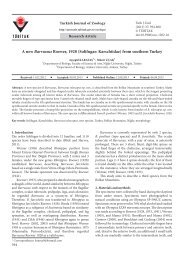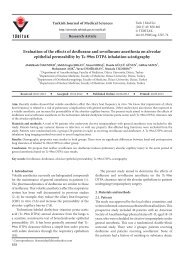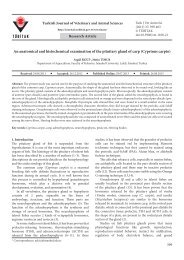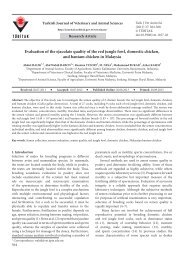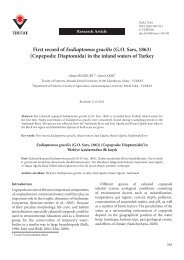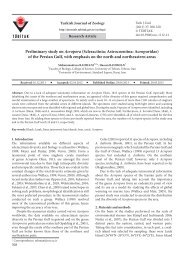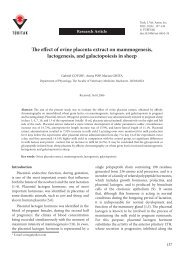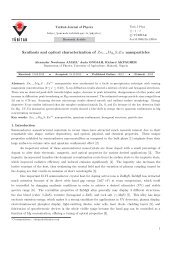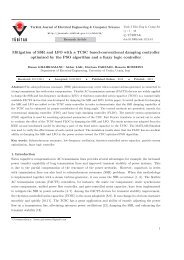Anti-inflammatory activity of Anthemis aciphylla var ... - Tübitak
Anti-inflammatory activity of Anthemis aciphylla var ... - Tübitak
Anti-inflammatory activity of Anthemis aciphylla var ... - Tübitak
You also want an ePaper? Increase the reach of your titles
YUMPU automatically turns print PDFs into web optimized ePapers that Google loves.
S. BALTACI, H. E. KOLATAN, O. YILMAZ, B. KIVÇAK<br />
Turk J Biol<br />
35 (2011) 757-762<br />
© TÜBİTAK<br />
doi:10.3906/biy-1006-15<br />
<strong>Anti</strong>-<strong>inflammatory</strong> <strong>activity</strong> <strong>of</strong> <strong>Anthemis</strong> <strong>aciphylla</strong> <strong>var</strong>.<br />
<strong>aciphylla</strong> Boiss.<br />
Sinem BALTACI 1 , Hatice Efsun KOLATAN 2 , Osman YILMAZ 2 , Bijen KIVÇAK 1<br />
1 Department <strong>of</strong> Pharmacognosy, Faculty <strong>of</strong> Pharmacy, Ege University, 35100 İzmir - TURKEY<br />
2 Department <strong>of</strong> Laboratory Animal Science, Dokuz Eylül University, 35340 İzmir - TURKEY<br />
Received: 18.06.2010<br />
Abstract: Ethanolic (EEAA) and sesquiterpene lactone (SEAA) extracts <strong>of</strong> the aerial parts <strong>of</strong> <strong>Anthemis</strong> <strong>aciphylla</strong> <strong>var</strong>.<br />
<strong>aciphylla</strong> Boiss. (Asteraceae) were evaluated for anti-<strong>inflammatory</strong> <strong>activity</strong> on carrageenin-induced paw edema (acute<br />
model) and cotton pellet-induced granuloma (chronic model) in rats. In carrageenin-induced paw edema, EEAA and<br />
SEAA at intraperitoneal doses <strong>of</strong> 50, 100, and 200 mg/kg dose-dependently inhibited the paw edema. In cotton pelletinduced<br />
granuloma, the oral administration <strong>of</strong> EEAA and SEAA at 50, 100, and 200 mg/kg dosages was also found to<br />
significantly inhibit granuloma tissue formation.<br />
Key words: <strong>Anthemis</strong> <strong>aciphylla</strong>, anti-<strong>inflammatory</strong> <strong>activity</strong>, carrageenin, paw edema, cotton pellet<br />
<strong>Anthemis</strong> <strong>aciphylla</strong> <strong>var</strong>. <strong>aciphylla</strong> Boiss.’in antienflamatu<strong>var</strong> aktivitesi<br />
Özet: <strong>Anthemis</strong> <strong>aciphylla</strong> <strong>var</strong>. <strong>aciphylla</strong> Boiss. (Asteraceae) bitkisinin topraküstü kısımlarından hazırlanan etanol<br />
(EEAA) ve seskiterpen lakton (SEAA) ekstrelerinin antienflamatu<strong>var</strong> aktivitesi, sıçanlarda karragen ile indüklenen<br />
pençe ödemi yöntemi (akut model) ve koton pelet ile indüklenen granülom teşekkülü (kronik model) yöntemiyle<br />
değerlendirilmiştir. Karragen ile indüklenen pençe ödemi yönteminde, EEAA ve SEAA ekstrelerinin, 50, 100, ve 200<br />
mg/kg dozlarda intraperitonal uygulanmasıyla, doza bağlı pençe ödemini önlediği gözlendi. Koton pelet ile indüklenen<br />
granülom teşekkülü yönteminde EEAA ve SEAA ekstrelerinin ayni dozlarda oral olarak verildiğinde önemli derecede<br />
granülom doku oluşumunu önlediği saptandı.<br />
Anahtar sözcükler: <strong>Anthemis</strong> <strong>aciphylla</strong>, anti-enflamatu<strong>var</strong> aktivite, karagenin, pençe ödemi, koton pelet<br />
Introduction<br />
The genus <strong>Anthemis</strong> L. (Asteraceae) is represented<br />
in the Flora <strong>of</strong> Turkey by 81 taxa belonging to 51<br />
species, 29 <strong>of</strong> which are endemic to Turkey (1).<br />
<strong>Anthemis</strong> <strong>aciphylla</strong> <strong>var</strong>. <strong>aciphylla</strong> Boiss. is one <strong>of</strong><br />
these endemic species (1,2). <strong>Anthemis</strong> species,<br />
known locally as papatya and yavşan, are extensively<br />
used in Turkish folk medicine for the treatment <strong>of</strong><br />
<strong>inflammatory</strong> disorders, menstrual pain, hepatic<br />
diseases, gastrointestinal disorders, hemorrhoid,<br />
stomachache, abdominal pain, and kidney stones<br />
(3-8). An infusion <strong>of</strong> the plant is taken for intestinal<br />
and abdominal colic and a decoction can be applied<br />
topically to sun-burned skin or skin affected by<br />
<strong>var</strong>ious types <strong>of</strong> inflammation (6,9).<br />
Sesquiterpene lactones, flavonoids, and<br />
polyacetylenes are the 3 main classes <strong>of</strong> secondary<br />
metabolites <strong>of</strong> the genus (10-12). Although several<br />
757
<strong>Anti</strong>-<strong>inflammatory</strong> <strong>activity</strong> <strong>of</strong> <strong>Anthemis</strong> <strong>aciphylla</strong> <strong>var</strong>. <strong>aciphylla</strong> Boiss.<br />
plants belonging to this genus have been shown to<br />
possess important anti-<strong>inflammatory</strong> (13), anti-<br />
Helicobacter pylori (10), antiprotozoal (14), and<br />
antimicrobial properties (15), there have been no<br />
reports on the biological <strong>activity</strong> <strong>of</strong> A. <strong>aciphylla</strong><br />
<strong>var</strong>. <strong>aciphylla</strong> Boiss to our knowledge. The present<br />
study was therefore undertaken to evaluate the<br />
anti-<strong>inflammatory</strong> <strong>activity</strong> <strong>of</strong> the ethanolic and<br />
sesquiterpene lactone extracts <strong>of</strong> the aerial parts <strong>of</strong> A.<br />
<strong>aciphylla</strong> <strong>var</strong>. <strong>aciphylla</strong> using 2 experimental models:<br />
carrageenin-induced paw edema and cotton pelletinduced<br />
granuloma in rats.<br />
Materials and methods<br />
Plant material<br />
In May 2007, the aerial parts <strong>of</strong> <strong>Anthemis</strong> <strong>aciphylla</strong><br />
<strong>var</strong>. <strong>aciphylla</strong> (Asteraceae) were collected from İzmir-<br />
Bayındır (Alankıyı village) in western Anatolia.<br />
These samples were identified by Ö. Seçmen from<br />
the Department <strong>of</strong> Biology, Botany Section, <strong>of</strong><br />
Ege University. A voucher specimen (No: 1365)<br />
was deposited in the Herbarium <strong>of</strong> the Faculty <strong>of</strong><br />
Pharmacy at Ege University in İzmir.<br />
Chemicals<br />
The chemicals used in this study were carrageenin<br />
(Sigma), indomethacin (Deva), and thiopental<br />
sodium (Abbott).<br />
Preparation <strong>of</strong> ethanolic extract <strong>of</strong> <strong>Anthemis</strong><br />
<strong>aciphylla</strong> <strong>var</strong>. <strong>aciphylla</strong> (EEAA)<br />
The air-dried and powdered samples <strong>of</strong> <strong>Anthemis</strong><br />
<strong>aciphylla</strong> <strong>var</strong>. <strong>aciphylla</strong> (500 g) were twice extracted<br />
with ethanol (3000 mL, first for 5 h and then for 8<br />
h) under stirring. The combined organic phases were<br />
filtered and distilled in vacuo (yield 11%).<br />
Preparation <strong>of</strong> sesquiterpene lactone extract <strong>of</strong><br />
<strong>Anthemis</strong> <strong>aciphylla</strong> <strong>var</strong>. <strong>aciphylla</strong> (SEAA)<br />
The dried aerial parts <strong>of</strong> <strong>Anthemis</strong> <strong>aciphylla</strong> <strong>var</strong>.<br />
<strong>aciphylla</strong> (8.68 kg) were finely ground and extracted<br />
at room temperature with cyclohexane-Et 2<br />
O-MeOH<br />
(1:1:1). The extract was then washed with brine; the<br />
aqueous layer was subjected to extraction once again<br />
with EtOAc, and the organic layer was dried with<br />
Na 2<br />
SO 4<br />
and concentrated under reduced pressure<br />
(yield 8%).<br />
Phytochemical Analysis<br />
Preliminary phytochemical screening was carried<br />
out on the EEAA and SEAA extracts using the<br />
standard screening method described by Trease and<br />
Evans (16).<br />
Animals<br />
Female Wistar rats (Laboratory Animal Science<br />
Department, Dokuz Eylül University, İzmir, Turkey)<br />
weighing 150-200 g were used. The animals were<br />
maintained under standard laboratory conditions<br />
<strong>of</strong> humidity, temperature (24 ± 2 °C), and light (12<br />
h day:12 h night), and allowed free access to food<br />
and water ad libitum. All experimental designs and<br />
procedures received approval from the Local Animal<br />
Ethics Committee <strong>of</strong> Dokuz Eylül University.<br />
<strong>Anti</strong>-<strong>inflammatory</strong> <strong>activity</strong> in vivo models<br />
Carrageenin-induced paw edema in rats (acute<br />
model)<br />
<strong>Anti</strong>-<strong>inflammatory</strong> <strong>activity</strong> was assessed by the<br />
method described by Winter et al (17).<br />
The rats were divided into 5 groups <strong>of</strong> 6 animals<br />
each. Group I (control) was treated with a 1% aqueous<br />
solution <strong>of</strong> sodium carboxymethylcellulose (CMS)<br />
(5 mL/kg) as a vehicle. Groups II, III, and IV were<br />
treated with EEAA and SEAA extracts at dosages <strong>of</strong><br />
200, 100, and 50 mg/kg, respectively. Our final group,<br />
Group V, was treated with 4 mg/kg indomethacin<br />
as a reference. Edema was induced by a subplanter<br />
injection <strong>of</strong> 0.1 mL <strong>of</strong> 1% (w/v) carrageenin (Sigma)<br />
into the right hind paw <strong>of</strong> each rat. The volume <strong>of</strong> the<br />
injected paws was measured using a plethysmometer<br />
(Plethysmometer 7140, Ugo Basile) 1, 2, 3, 4, and<br />
5 h after the induction <strong>of</strong> inflammation. The test<br />
groups received the extract (50-200 mg/kg), the<br />
reference group received indomethacin (4 mg/kg),<br />
and the control animals received the vehicle only. All<br />
the doses were given intraperitoneally. The EEAA<br />
and SEAA extracts (200, 100, or 50 mg/kg) were<br />
given intraperitoneally 1 h prior to the injection <strong>of</strong><br />
carrageenin. The inhibitory <strong>activity</strong> was calculated<br />
according to the following formula (18):<br />
% Inhibition = (Ct – Co) control – (Ct – Co)<br />
treated/(Ct – Co) control × 100<br />
where Ct = the paw circumference at time t, Co = the<br />
paw circumference before the carrageenin injection,<br />
and Ct – Co = edema.<br />
758
S. BALTACI, H. E. KOLATAN, O. YILMAZ, B. KIVÇAK<br />
Cotton pellet-induced granuloma in rats (chronic<br />
model)<br />
The rats were divided into 5 groups with 5 animals<br />
in each group. After being shaved, the animals were<br />
anaesthetized with an intraperitoneal injection<br />
<strong>of</strong> 25 mg/kg thiopental sodium. Through a single<br />
needle incision, sterile pre-weighed cotton pellets<br />
(50 mg) were implanted in the dorsal region <strong>of</strong> each<br />
rat. The extracts (200, 100, or 50 mg/kg), reference<br />
drug indomethacin (5 mg/kg), and control vehicle<br />
were administered orally to the respective group <strong>of</strong><br />
animals for 7 consecutive days following the day <strong>of</strong><br />
cotton-pellet implantation. On the eighth day, the<br />
animals were anaesthetized again and the cotton<br />
pellets were surgically removed and freed from<br />
extraneous tissues. The pellets were then incubated<br />
at 37 °C for 24 h and dried at 60 °C to constant<br />
weight. The increase in the dry weight <strong>of</strong> the pellets<br />
was taken as the measure <strong>of</strong> granuloma formation.<br />
The percentage <strong>of</strong> inhibition increase in the weight<br />
<strong>of</strong> the cotton pellet was calculated according to the<br />
following formula (19):<br />
% Inhibition = Wc – Wd/Wc × 100<br />
where Wd = the difference in pellet weight <strong>of</strong> the<br />
drug treated group and Wc = the difference in pellet<br />
weight <strong>of</strong> the control group.<br />
Data analysis<br />
Values reported are expressed as mean ± S.E.M.<br />
The statistical comparison <strong>of</strong> data was made by<br />
means <strong>of</strong> one way ANOVA using a Dunnett’s test,<br />
performed using Graph Pad InStat. For the purposes<br />
<strong>of</strong> the present study, P < 0.001 was regarded as<br />
significant.<br />
Results and discussion<br />
In the anti-<strong>inflammatory</strong> studies, the results<br />
show that pretreatments with the EEAA and SEAA<br />
extracts (200, 100, or 50 mg/kg) and indomethacin<br />
significantly (P < 0.001) inhibited both carrageenininduced<br />
paw edema (acute model) (Tables 1 and<br />
2) and cotton pellet-induced granuloma tissue<br />
formation (chronic model) (Tables 3 and 4).<br />
Carrageenin-induced rat paw edema is widely<br />
used as an experimental animal model for the<br />
evaluation <strong>of</strong> anti-<strong>inflammatory</strong> potential in natural<br />
products (20). The present study establishes the anti<strong>inflammatory</strong><br />
<strong>activity</strong> <strong>of</strong> the EEAA and SEAA extracts<br />
in the models used. The pretreatment <strong>of</strong> animals with<br />
EEAA and SEAA extracts resulted in a significant<br />
and dose-related inhibition <strong>of</strong> carrageenin-evoked<br />
hind paw edema. The reference drug indomethacin<br />
also showed significant edema inhibition in all the<br />
phases. Among the EEAA and SEAA extracts, the<br />
SEAA extract (200 mg/kg) exhibited significant<br />
anti-<strong>inflammatory</strong> <strong>activity</strong> (75%, 71.42%, 69.81%,<br />
77.04%) at 1 h, 2 h, 3 h, 4 h post-procedure, which<br />
was comparable to that <strong>of</strong> indomethacin (85.71%,<br />
78.57%, 79.24%, 86.88%) (Table 2).<br />
Table 1. The effects <strong>of</strong> the ethanolic extract <strong>of</strong> A. <strong>aciphylla</strong> <strong>var</strong>. <strong>aciphylla</strong> (EEAA) on carrageenin-induced paw edema in rats.<br />
Treatment and dose<br />
(mg/kg, IP)<br />
Right paw volume (mL × 100)<br />
0 h 1 h 2 h 3 h 4 h 5 h<br />
Control 0.90 ± 0.0081 1.15 ± 0.0088 1.21 ± 0.0137 1.25 ± 0.0157 1.28 ± 0.0163 1.26 ± 0.0160<br />
EEAA (50 mg/kg) 0.90 ± 0,0105<br />
1.08 ± 0.0094*<br />
(28)<br />
1.11 ± 0.0091*<br />
(32.25)<br />
1.15 ± 0.0113*<br />
(28.57)<br />
1.17 ± 0.0094*<br />
(28.94)<br />
1.15 ± 0.0102*<br />
(30.55)<br />
EEAA (100 mg/kg) 0.90 ± 0,0088<br />
1.05 ± 0.0196*<br />
(40)<br />
1.08 ± 0.0070*<br />
(41.93)<br />
1.10 ± 0.0083*<br />
(42.85)<br />
1.12 ± 0.0076*<br />
(42.10)<br />
1.10 ± 0.0067*<br />
(44.44)<br />
EEAA (200 mg/kg) 0.90 ± 0.0068<br />
0.98 ± 0.0061*<br />
(68)<br />
1.01 ± 0.0070*<br />
(64.51)<br />
1.03 ± 0.0055*<br />
(62.85)<br />
1.06 ± 0.0080*<br />
(57.89)<br />
1.05 ± 0.0076*<br />
(58.33)<br />
Indomethacin (4 mg/kg)<br />
0.90 ± 0.0070 0.93 ± 0.0060*<br />
(88)<br />
0.97 ± 0.0066*<br />
(77.41)<br />
1.00 ± 0.0172*<br />
(71.42)<br />
0.98 ± 0.0057*<br />
(78.94)<br />
0.97 ± 0.0071*<br />
(80.55)<br />
* Significantly different from control, P < 0.001 (ANOVA followed by Dunnett’s test). Values in parentheses indicate the percentage inhibition rate.<br />
759
<strong>Anti</strong>-<strong>inflammatory</strong> <strong>activity</strong> <strong>of</strong> <strong>Anthemis</strong> <strong>aciphylla</strong> <strong>var</strong>. <strong>aciphylla</strong> Boiss.<br />
Table 2. The effects <strong>of</strong> the sesquiterpene lactone extract <strong>of</strong> A. <strong>aciphylla</strong> <strong>var</strong>. <strong>aciphylla</strong> (SEAA) on carrageenin-induced paw edema in rats.<br />
Treatment and dose<br />
(mg/kg, IP)<br />
Right paw volume (mL × 100)<br />
0 h 1 h 2 h 3 h 4 h 5 h<br />
Control 0.88 ± 0.0091 1.16 ± 0.0061 1.30 ± 0.0087 1.41 ± 0.0116 1.49 ± 0.0125 1.49 ± 0.0101<br />
SE AA (50 mg/kg) 0.89 ± 0.0088<br />
1.05 ± 0.0101*<br />
(42.85)<br />
1.13 ± 0.0080*<br />
(42.85)<br />
1.19 ± 0.0088*<br />
(43.39)<br />
1.23 ± 0.0094*<br />
(44.26)<br />
1.22 ± 0.0080*<br />
(45.90)<br />
SEAA (100 mg/kg) 0.89 ± 0.0076<br />
1.00 ± 0.0080*<br />
(60.71)<br />
1.06 ± 0.0090*<br />
(59.52)<br />
1.11 ± 0.0084*<br />
(58.49)<br />
1.11 ± 0.0085*<br />
(63.93)<br />
1.09 ± 0.0095*<br />
(67.21)<br />
SEAA (200 mg/kg) 0.89 ± 0.0066<br />
0.96 ± 0.0098*<br />
(75)<br />
1.01 ± 0.0095*<br />
(71.42)<br />
1.05 ± 0.0103*<br />
(69.81)<br />
1.03 ± 0.0084*<br />
(77.04)<br />
1.02 ± 0.0081*<br />
(78.68)<br />
Indomethacin (4 mg/kg)<br />
0.89 ± 0.0063 0.93 ± 0.0066*<br />
(85.71)<br />
0.98 ± 0.0047*<br />
(78.57)<br />
1.00 ± 0.0047*<br />
(79.24)<br />
0.97 ± 0.0060*<br />
(86.88)<br />
0.95 ± 0.0061*<br />
(90.16)<br />
* Significantly different from control, P < 0.001 (ANOVA followed by Dunnett’s test). Values in parentheses indicate the percentage inhibition rate.<br />
Table 3. The effects <strong>of</strong> the ethanolic extract <strong>of</strong> A. <strong>aciphylla</strong> <strong>var</strong>. <strong>aciphylla</strong> (EEAA) on the weight <strong>of</strong><br />
granuloma formation in rats.<br />
Treatment and dose (mg/kg, PO) Weight <strong>of</strong> granuloma (mg) Percentage inhibition<br />
Control 157.72 ± 0.2297 0<br />
EEAA (50 mg/kg) 98.81 ± 0.2369* 37.35<br />
EEAA (100 mg/kg) 86.92 ± 0.2845* 44.88<br />
EEAA (200 mg/kg) 71.18 ± 0.1928* 54.86<br />
Indomethacin (5 mg/kg) 60.44 ± 0.3219* 61.67<br />
*Significantly different from control, P < 0.001 (ANOVA followed by Dunnett’s test).<br />
Table 4. The effects <strong>of</strong> the sesquiterpene lactone extract <strong>of</strong> A. <strong>aciphylla</strong> <strong>var</strong>. <strong>aciphylla</strong> (SEAA) on the<br />
weight <strong>of</strong> granuloma formation in rats.<br />
Treatment and dose (mg/kg, PO) Weight <strong>of</strong> granuloma (mg) Percentage inhibition<br />
Control 135.23 ± 0.4122 0<br />
SEAA (50 mg/kg) 82.19 ± 0.5227* 39.22<br />
SEAA(100 mg/kg) 43.01 ± 0.4528* 68.19<br />
SEAA (200 mg/kg) 31.86 ± 0.4103* 76.44<br />
Indomethacin (5 mg/kg) 25.53 ± 0.3535* 81.12<br />
*Significantly different from control, P < 0.001 (ANOVA followed by Dunnett’s test).<br />
760
S. BALTACI, H. E. KOLATAN, O. YILMAZ, B. KIVÇAK<br />
Similarly, in the cotton pellet granuloma model<br />
<strong>of</strong> inflammation, the EEAA and SEAA extracts<br />
(200, 100, and 50 mg/kg) inhibited the granuloma<br />
formation significantly (P < 0.001), indicating that<br />
the extracts can also inhibit the chronic <strong>inflammatory</strong><br />
process typified by the cotton pellet method (21).<br />
Among the EEAA and SEAA extracts, the SEAA<br />
extract (200 mg/kg) exhibited significant anti<strong>inflammatory</strong><br />
<strong>activity</strong> (76.44%) comparable to that<br />
<strong>of</strong> indomethacin (81.12%) (Table 4).<br />
A phytochemical screening <strong>of</strong> the EEAA extract<br />
indicated the presence <strong>of</strong> the following secondary<br />
metabolites: flavonoids and saponins in high<br />
concentrations, as well as tannins in moderate<br />
concentration. The EEAA extract was, however,<br />
devoid <strong>of</strong> alkaloids and sesquiterpene lactones.<br />
Secondary metabolites in the SEAA extract included<br />
sesquiterpene lactones, flavonoids, and saponins<br />
in high concentrations and tannins in a low<br />
concentration. As with the EEAA extract, the SEAA<br />
extract was devoid <strong>of</strong> alkaloids.<br />
In the present study, the anti-<strong>inflammatory</strong><br />
<strong>activity</strong> <strong>of</strong> EEAA and SEAA extracts were evaluated<br />
in both acute and chronic in vivo models.<br />
The accumulation <strong>of</strong> edema fluid as a function<br />
<strong>of</strong> time after the subplantar injection <strong>of</strong> the irritant<br />
(carrageenin) in rats is biphasic (22). Histamine and<br />
serotonin are usually responsible for eliciting the<br />
immediate response <strong>of</strong> inflammation in rats (first<br />
phase), whereas kinins and prostaglandins (PG)<br />
mediate the more prolonged delayed-onset responses<br />
(second phase) (23). From the results obtained, it<br />
can be inferred that the inhibitory effects <strong>of</strong> the<br />
EEAA and SEAA extracts on carrageenin-induced<br />
inflammation in rats could be due to inhibition <strong>of</strong> the<br />
enzyme cyclooxygenase, which in turn leads to the<br />
inhibition <strong>of</strong> PG synthesis. The decrease in edema<br />
inhibition at 5.5 h may be a result <strong>of</strong> the increased<br />
generation <strong>of</strong> leukotrienes at that stage caused by the<br />
inhibition <strong>of</strong> PG synthesis in the second phase, since<br />
inhibition <strong>of</strong> PG synthesis diverts the reaction toward<br />
an increase in leukotriene synthesis (24).<br />
The <strong>inflammatory</strong> response to a subcutaneously<br />
implanted cotton pellet in rats has been described<br />
in 3 phases: (1) a transudative phase, defined as<br />
the increase in wet weight <strong>of</strong> the pellet occurring<br />
during the first 3 h; (2) an exudative phase, occurring<br />
between 3 and 72 h after the pellet is implanted; and<br />
(3) a proliferative phase, measured as the increase<br />
in dry weight <strong>of</strong> the granuloma that occurs between<br />
3 and 6 days after implantation (25). The results<br />
indicate that both the EEAA and SEAA extracts<br />
exhibited significant (P < 0.001) antitransudative and<br />
antiproliferative effects by inhibiting both the wet and<br />
dry weights <strong>of</strong> cotton pellets when compared with the<br />
control. This finding reflects its efficacy in inhibiting<br />
the increase in the number <strong>of</strong> fibroblasts and the<br />
synthesis <strong>of</strong> collagen and mucopolysaccharide, which<br />
are natural proliferative events during granulation<br />
tissue formation (26). The effect <strong>of</strong> the extracts on the<br />
inflammation process induced by stimulus injection<br />
indicates that these agents act by affecting a timedelayed<br />
system in a similar fashion to glucocorticoids.<br />
Preliminary phytochemical analysis <strong>of</strong> the EEAA<br />
and SEAA extracts shows the presence <strong>of</strong> flavonoids,<br />
saponins, and tannins. Furthermore, sesquiterpene<br />
lactones were also detected in the SEAA extract.<br />
These bioactive agents (flavonoids, saponins,<br />
and sesquiterpene lactones) have the ability to<br />
inhibit pain perception and can also serve as anti<strong>inflammatory</strong><br />
agents (27,28). The EEAA and SEAA<br />
extracts exhibited significant anti-<strong>inflammatory</strong><br />
potential at the dose levels examined in this study.<br />
More detailed phytochemical studies are, however,<br />
necessary to identify the active principle(s) and exact<br />
mechanism(s) <strong>of</strong> action.<br />
Acknowledgments<br />
This research was supported by Ege University’s<br />
Research Fund (No. 2008/ECZ/001), İzmir, Turkey.<br />
Corresponding author:<br />
Bijen KIVÇAK<br />
Department <strong>of</strong> Pharmacognosy,<br />
Faculty <strong>of</strong> Pharmacy,<br />
Ege University, 35100 İzmir - TURKEY<br />
E-mail: bijen.kivcak@ege.edu.tr<br />
761
<strong>Anti</strong>-<strong>inflammatory</strong> <strong>activity</strong> <strong>of</strong> <strong>Anthemis</strong> <strong>aciphylla</strong> <strong>var</strong>. <strong>aciphylla</strong> Boiss.<br />
References<br />
1. Davis PH. <strong>Anthemis</strong> L., pp. 174-192. In: Davis PH. (ed.) Flora<br />
<strong>of</strong> Turkey and the East Aegean Islands, Vol. 1. Edinburgh<br />
University Press, 1965.<br />
2. Güner A, Özhatay N, Ekim T et al. (eds.) Flora <strong>of</strong> Turkey and<br />
the East Aegean Islands Supplement 2 , Vol. 11. Edinburgh<br />
University Press. 2000: pp.194-202.<br />
3. Baytop T. Therapy with Medicinal Plants in Turkey (Past and<br />
Present), No. 3255. Publication <strong>of</strong> İstanbul University. İstanbul,<br />
1984.<br />
4. Gürhan G, Ezer N. Halk Arasında Hemoroit Tedavisinde<br />
Kullanılan Bitkiler-I. Hac Univ J Fac Pharm 2: 37-60, 2004.<br />
5. Ugurlu E, Secmen O. Medicinal plants popularly used in the<br />
villages <strong>of</strong> Yunt Mountain (Manisa- Turkey). Fitoterapia 79:<br />
126-131, 2008.<br />
6. Honda G, Yeşilada E, Tabata M et al. Traditional medicine in<br />
Turkey. VI. Folk medicine in west Anatolia: Afyon, Kütahya,<br />
Denizli, Muğla, Aydin provinces. J Ethnopharmacol 53: 75-87,<br />
1996.<br />
7. Mann C, Staba EJ. The chemistry, pharmacology, and<br />
commercial formulations <strong>of</strong> chamomile. In: Craker LE,<br />
Simon J. (eds.) Herbs, Spices, and Medicinal Plants. Recent<br />
Advances in Botany, Horticulture, and Pharmacology, Vol. 1.<br />
Binghamton, NY: Haworth Press; 1986: 235-280.<br />
8. Petkeviciute Z, Savickiene N, Savickas A et al. Urban<br />
ethnobotany study in Samogitia region, Lithuania. J Med<br />
Plants Res 4: 64-71, 2010.<br />
9. Manganenelli Uncini RE, Tomei PE. Ethnopharmacobotanical<br />
studies <strong>of</strong> the Tuscan Archipelago. J Ethnopharmacol 65: 181-<br />
202, 1999.<br />
10. Konstantinopoulou M, Karioti A, Skaltsas S et al. Sesquiterpene<br />
lactones from <strong>Anthemis</strong> altissima and their anti-helicobacter<br />
pylori <strong>activity</strong>. J Nat Prod 66: 699-702, 2003.<br />
11. Vuckovic I, Vujusic L, Milosavljevic S. Phytochemical<br />
investigation <strong>of</strong> <strong>Anthemis</strong> cotula L. Serb Chem Soc 71: 127-133,<br />
2005.<br />
12. Christensen LP. Acethylenes and related compounds in<br />
Anthemidae. Phytochemistry 31: 47-51, 1992<br />
13. Gegauer H. Pharmacological effects <strong>of</strong> chamomile active<br />
ingredients. S<strong>of</strong>w J 34: 36-38, 2006.<br />
14. Karioti A, Skaltsa H, Linden A et al. Anthecularin: A novel<br />
sesquiterpene lactone from <strong>Anthemis</strong> auriculata with<br />
antiprotozoal <strong>activity</strong>. J Org Chem 72: 8103-8106, 2007.<br />
15. Kurtulmus A, Fafal T, Mert T et al. Chemical composition and<br />
antimicrobial <strong>activity</strong> <strong>of</strong> the essential oils <strong>of</strong> three <strong>Anthemis</strong><br />
species from Turkey. Chem Nat Com 45: 900-904, 2009.<br />
16. Trease CE, Evans UC. Textbook <strong>of</strong> Pharmacognosy. Bailliere<br />
Tindall. London; 1984.<br />
17. Winter CA, Risley EA, Nuss GW. Carrageenin-induced edema<br />
in hind paw <strong>of</strong> the rats as an assay for anti<strong>inflammatory</strong> drugs.<br />
Proc Soc Exp Bio Med 111: 544-547, 1962.<br />
18. Olajide OA, Awe SO, Makinde JO et al. Studies on the anti<strong>inflammatory</strong>,<br />
antipyretic and analgesic properties <strong>of</strong> Alstonia<br />
boonei stem bark. J Ethnopharmacol 71: 179-186, 2000.<br />
19. Winter CA, Porter CC. Effect <strong>of</strong> alteration in side chain upon<br />
anti-<strong>inflammatory</strong> and liver glycogen activities hydrocortisone<br />
esters. J Am Pharm Assoc 46: 515-519, 1957.<br />
20. Winter CA. The mechanism <strong>of</strong> action <strong>of</strong> non-steroid anti<strong>inflammatory</strong><br />
drugs. Arzneim-Forsch 21: 1805-1811, 1971.<br />
21. Ismail TS, Gapalakrisan S, Begum VH et al. <strong>Anti</strong>-<strong>inflammatory</strong><br />
<strong>activity</strong> <strong>of</strong> Salacia oblonga Wall and Azima tetracantha Lam. J<br />
Ethnopharmacol 56: 145-152, 1997.<br />
22. Vinegar R, Schrieber W, Hugo R. Biphasic development <strong>of</strong><br />
carrageenan edema in rats. J Pharmacol Exp Ther 166: 96-103,<br />
1969.<br />
23. Vane J, Botting R. Inflammation and the mechanism <strong>of</strong> action<br />
<strong>of</strong> anti-<strong>inflammatory</strong> drugs. Faseb J 1: 89-96, 1987.<br />
24. Mayes PA. Metabolism <strong>of</strong> unsaturated fatty acids and<br />
eicosanoids, pp. 236-244. In: Murray RK, Granner DK, Mayes<br />
Pa, Rodwell VW. Harper’s Biochemistry. Prentice-Hall; 1996.<br />
25. Swingle KF, Shideman FE. Phases <strong>of</strong> <strong>inflammatory</strong> response<br />
to subcutaneous implantation <strong>of</strong> a cotton pellet and their<br />
modification by certain anti-<strong>inflammatory</strong> agents. J Pharmacol<br />
Exp Ther 183: 226-234, 1972.<br />
26. Arrigoni-Martellie E. Inflammation and <strong>Anti</strong>-<strong>inflammatory</strong>.<br />
Spectrum Publications. New York, 1977.<br />
27. Berknow R. The Merck Manual <strong>of</strong> Diagnosis and Therapy.<br />
Merck Research Laboratories, Rathway. New Jersey, 1992.<br />
28. Facino RM ,Carini M, Adlini G et al. Free radicals scavenging<br />
action and anti-enzyme activities <strong>of</strong> ptocynanidins from Vitis<br />
vinifera. Arzneim-Forsch/DrugRes 44: 592-601, 1994.<br />
762



